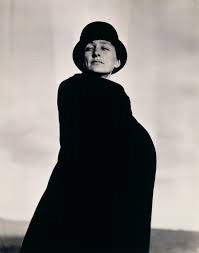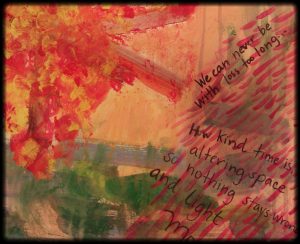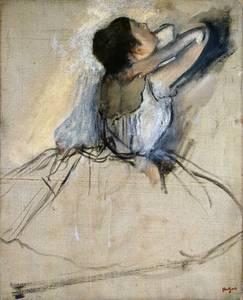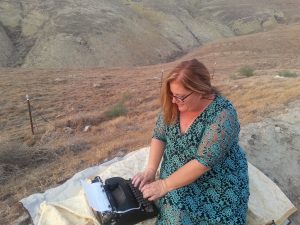 Perhaps it is my theme reveal for the A to Z Challenge that has me thinking of Literary Grannies and Creative Makers who are trailblazing women, I don’t know exactly but for whatever reason, Georgia O’Keeffe sprang into mind today and I spontaneously posted an image and a quote of hers on Instagram. A quote about the ferocity of fear and the equally tenacious quality of creative life force.
Perhaps it is my theme reveal for the A to Z Challenge that has me thinking of Literary Grannies and Creative Makers who are trailblazing women, I don’t know exactly but for whatever reason, Georgia O’Keeffe sprang into mind today and I spontaneously posted an image and a quote of hers on Instagram. A quote about the ferocity of fear and the equally tenacious quality of creative life force.
I had studied Georgia O’Keeffe years ago so I decided to look in my old blog to see if I could find anything relevant.
There, nine years ago, I was with Samuel (then Sam) on a mini-roadtrip-turned-too-long and her presence was quite strong. Here is what I wrote then:
It was the end of Spring break and tech week for “The Winter’s Tale”. The last ten days were rapidly fading in memory. They left behind a tired, soul aching me, sitting at my porch desk as the day faded.
I had no words left.
 Instead of conventional language I had three blobs of paint on a paper plate palette, a brush, water and a piece of paper I had torn angrily into four more-or-less equal pieces.
Instead of conventional language I had three blobs of paint on a paper plate palette, a brush, water and a piece of paper I had torn angrily into four more-or-less equal pieces.
Samuel and I had arrived home to an empty house following a trip to the Los Angeles airport. We were held tightly during eight hour round trip (due to traffic) into a cocoon in the back seat of a small car. He sat peacefully watching a hand-held GPS device while I allowed thoughts to flicker and flow through me and eventually brought me to this speechless frustration-laden perch on
my front porch that commanded me “Paint! Without question.”
“P!A!I!N!T!”
So I did exactly that. I just painted.
I dipped my brush into the blue-ish blob and added a touch of red and the speechless frustration turned into groaning, angry, somewhat muffled choking as I put the odd-colored paint onto the page and became even angrier at what I created.
 “This is not the color I wanted,” my soul lamented silently. From my lips came words I didn’t know were there. “I hate you, oh how I hate you. I h a t e you!”
“This is not the color I wanted,” my soul lamented silently. From my lips came words I didn’t know were there. “I hate you, oh how I hate you. I h a t e you!”
Where was “this” coming from, I wondered, and what was “this” talking about, why was I so angry and what did I hate?
These questions rose up and washed away as I splattered color and water on one square and it leaped onto the other squares, skittering and scattering from the tempestuousness of my brush beating.
I rinsed my brush, dried it and dabbled into a sweet shade of yellow. I made a box, wanting to practice the shapes and lines as called on by one of my book-learning-painting teachers I met with success-failure and kept painting.
My anger met my breath and I mixed my intention with the paper, water and color, making brush shaped rectangles of orangey-red and then yellow-y orange. My square-once-house became a pastoral scene.
I felt peace rising.
I continued. I continued again and again, two more times. I painted what came, painted what I felt. I sat there, painting, painting, painting.
It felt like hours had passed and it felt like no time had passed.
What happened next surprised me.
I reached out to the initial attempt at painting. When I wasn’t looking, the angry, blue-ish blob that overflowed with contempt had become something beautiful.
It had become beauty itself.
 Edgar Degas said it like this: “Only when he no longer knows what he is doing does the painter do good things.”
Edgar Degas said it like this: “Only when he no longer knows what he is doing does the painter do good things.”
Even if the only person ever impacted by this painting spree at my porch desk is me, it was and is and will continue to be a good thing.
“Good thing” doesn’t begin to express it.
Georgia O’Keeffe reminds me in her words, “I found I could say things with color and shapes that I couldn’t say any other way–things I had no words for.”
This painting episode was different than anything I had ever felt. The “must paint” feeling was overwhelming, stronger than any other creative call I have ever had – perhaps because I needed to listen to the message from the paint.
I needed to be the speaker, the conduit, the artist, the audience, the emcee, the chorus, the straight-man and be none of these because the paint overtook everything. It merged with my emotion: it became anger and frustration. The brush and the paint and the water and the paper were as much a part of me as my skin, my blood, my muscles, my bones.
Tears came and washed everything “just right”.
Tears didn’t wash it clean because clean and dirty aren’t relevant.
Comparison – in the moment – doesn’t matter, it is needless. It no longer carries the markings of meaning because tears came and washed everything into a wordless version of “just right”.
I don’t need language dense words to know the exact word-language definition of “just right” because I am intimate, on a soul level, with the wordless “just right”.
I don’t need language dense words to step into the questions the paint answered so vividly for me, for you, for us.
It is as it is, raw and unedited – unmolded, without words, just right.
 Julie Jordan Scott inspires people to experience artistic rebirth via her programs, playshops, books, performances and simply being herself out in the world. She created the process #5for5BrainDump that has birthed books, breakthroughs and many more livestream broadcasts. Participate in this process via livestream – to check the current schedule visit #5for5HQ
Julie Jordan Scott inspires people to experience artistic rebirth via her programs, playshops, books, performances and simply being herself out in the world. She created the process #5for5BrainDump that has birthed books, breakthroughs and many more livestream broadcasts. Participate in this process via livestream – to check the current schedule visit #5for5HQ
She is also a writer, creative life coach, speaker, performance poet, Mommy-extraordinaire and mixed media artist whose Writing Camps and Writing Playgrounds permanently transform people’s creative lives. Watch for the announcement of new programs coming in soon!
To contact Julie to schedule a Writing or Creative Life Coaching Session, call or text her at 661.444.2735.